Overview
- Description
- The Alfred Fabian papers consist of identification papers and photographs documenting Holocaust survivor Alfred Fabian, the Buchenwald camp, family members who perished in the Holocaust, and Fabian’s immigration to the United States. Identification papers include Fabian’s provisional identification card for civilian internees of Buchenwald and his Hebrew Immigrant Aid Society identification certificate. Photographs depict a pile of corpses at Buchenwald, Weimar citizens on a forced visit to the liberated camp, flags in front of a sign expressing the gratitude of liberated Czechoslovakian Buchenwald survivors, and a memorial stone for the Fabian family including Siegfried, Erna, Ruth, Ingrid, Siegbert, and Margot.
- Date
-
inclusive:
1945-1947
- Credit Line
- United States Holocaust Memorial Museum Collection, Gift of Alfred Fabian
- Collection Creator
- Alfred Fabian
- Biography
-
Alfred Fabian was born on May 24, 1910, in Neumark, Germany (now Nowe Miasto Lubawskie, Poland), to a Jewish couple. Alfred’s mother was Erna Leyser Fabian, who was born on December 19, 1882, in Culmsee, Prussia (Chelmza, Poland). Alfred’s father died in 1921 at age 41. Alfred was a gardener and lived in Berlin. He married Ruth Imber, who was born on February 23, 1909, in Schulitz, Kreis Bromberg, Germany (Bydgoszcz, Poland), to Elias and Erstina Koralczyk Imber.
In January 1933, Hitler came to power in Germany. Anti-Semitic policies were enacted soon after. On January 23, 1938, Alfred and Ruth had a daughter, Ingrid Johanna. On November 9, 1938, during Kristallnacht, Alfred witnessed the synagogue being destroyed. On September 1, 1941, Jews over the age of six were required to wear yellow Star of David badges. On May 10, 1943, Alfred, Ruth, Ingrid, and Alfred’s mother Erna were arrested by the Gestapo and brought to the Hamburgerstrasse clearing station in Berlin. On May 17, they were deported to Theresienstadt ghetto-labor camp in Czechoslovakia. On October 12, 1944, they were transferred to Auschwitz-Birkenau killing center on Transport Eq. Alfred’s wife, daughter, and mother were murdered on October 13, the day they arrived. In November 1944, Alfred was transferred to Niederorschel slave labor camp, a Buchenwald subcamp in Germany that provided worked for Junkers-Werke aircraft factories. He arrived on November 19 and was assigned prisoner number 95769. On April 1, 1945, Niederorschel was evacuated. Alfred was sent to Buchenwald concentration camp. On April 11, Alfred was liberated in Buchenwald by the 761st Tank Battalion, US Army.
On May 6, Alfred was released from the custody of the US Army. He returned to Berlin. Alfred’s father- and mother-in-law, Elias and Erstina, survived imprisonment in Theresienstadt. The rest of his family perished. On June 12, 1947, Alfred sailed from Bremen on the SS Ernie Pyle, arriving in New York on June 22. He was sponsored by the Hebrew Immigrant Aid Society (HIAS). Alfred, age 88, died on November 5, 1998, in Bradley Beach, New Jersey.
Physical Details
- Genre/Form
- Photographs.
- Extent
-
2 folders
- System of Arrangement
- The Alfred Fabian papers are arranged as a single series: I. Alfred Fabian papers, 1945-1947
Rights & Restrictions
- Conditions on Access
- There are no known restrictions on access to this material.
- Conditions on Use
- Material(s) in this collection may be protected by copyright and/or related rights. You do not require further permission from the Museum to use this material. The user is solely responsible for making a determination as to if and how the material may be used.
Keywords & Subjects
- Topical Term
- Jews--Poland--Nowa Marchia. Jews--Germany--Berlin. Holocaust survivors--Germany. Holocaust victims--Germany.
- Geographic Name
- Nowa Marchia (Poland) Weimar (Thuringia, Germany) United States--Emigration and immigration--History--20th century.
- Corporate Name
- Buchenwald (Concentration camp)
Administrative Notes
- Holder of Originals
-
United States Holocaust Memorial Museum
- Legal Status
- Permanent Collection
- Provenance
- Alfred Fabian donated the Alfred Fabian papers to the United States Holocaust Memorial Museum in 1995 and 1996. The accession formerly cataloged as 1996.11 has been incorporated into this collection.
- Funding Note
- The cataloging of this collection has been supported by a grant from the Conference on Jewish Material Claims Against Germany.
- Primary Number
- 1995.78.11
- Record last modified:
- 2023-03-30 15:12:16
- This page:
- https://collections.ushmm.org/search/catalog/irn531458
Additional Resources
Download & Licensing
In-Person Research
- Available for Research
- Plan a Research Visit
-
Request in Shapell Center Reading Room
Bowie, MD
Contact Us
Also in Alfred Fabian collection
The collection consists of two prisoner patches, a Star of David badge, documents, and photographs relating to the experiences of Alfred Fabian during the Holocaust in Germany and Czechoslovakia and after the Holocaust in Germany.
Date: 1941-1947
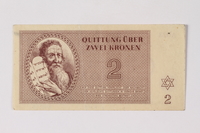
Theresienstadt ghetto-labor camp scrip, 2 kronen note, saved by a former German Jewish inmate
Object
Theresienstadt scrip, value 2 [zwei] kronen, acquired by Alfred Fabian, an inmate in Theresienstadt ghetto-labor camp in German occupied Czechoslovakia from March 1943-October 1944. Currency was confiscated from deportees and the SS ordered the Jewish Council to create a currency for exchange only in the camp. This was to create an illusion of normalcy and there was little to buy. On May 17, 1943, Alfred, wife Ruth, 5 year old daughter Ingrid, and Alfred’s mother Erna were deported to Theresienstadt. On October 12, 1944, the family was sent to Auschwitz-Birkenau killing center, where Ruth, Ingrid, and Erna were gassed on arrival. On November 19, 1944, Alfred was sent to Niederorschel slave labor camp, a Buchenwald subcamp in Germany. Niederorschel was evacuated on April 1, 1945. Alfred was sent to Buchenwald where he was liberated April 11 by the 761st Tank Battalion, US Army.
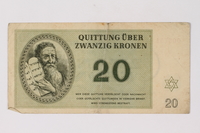
Theresienstadt ghetto-labor camp scrip, 20 kronen note, saved by a former German Jewish inmate
Object
Theresienstadt scrip, value 20 [zwanzig] kronen, acquired by Alfred Fabian, an inmate in Theresienstadt ghetto-labor camp in German occupied Czechoslovakia from March 1943-October 1944. Currency was confiscated from deportees and the SS ordered the Jewish Council to create a currency for exchange only in the camp. This was to create an illusion of normalcy and there was little to buy. On May 17, 1943, Alfred, wife Ruth, 5 year old daughter Ingrid, and Alfred’s mother Erna were deported to Theresienstadt. On October 12, 1944, the family was sent to Auschwitz-Birkenau killing center, where Ruth, Ingrid, and Erna were gassed on arrival. On November 19, 1944, Alfred was sent to Niederorschel slave labor camp, a Buchenwald subcamp in Germany. Niederorschel was evacuated on April 1, 1945. Alfred was sent to Buchenwald where he was liberated April 11 by the 761st Tank Battalion, US Army.
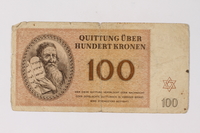
Theresienstadt ghetto-labor camp scrip, 100 kronen note, saved by a former German Jewish inmate
Object
Theresienstadt scrip, value 100 [eine hundert] kronen, acquired by Alfred Fabian, an inmate in Theresienstadt ghetto-labor camp in German occupied Czechoslovakia from March 1943-October 1944. Currency was confiscated from deportees and the SS ordered the Jewish Council to create a currency for exchange only in the camp. This was to create an illusion of normalcy and there was little to buy. On May 17, 1943, Alfred, wife Ruth, 5 year old daughter Ingrid, and Alfred’s mother Erna were deported to Theresienstadt. On October 12, 1944, the family was sent to Auschwitz-Birkenau killing center, where Ruth, Ingrid, and Erna were gassed on arrival. On November 19, 1944, Alfred was sent to Niederorschel slave labor camp, a Buchenwald subcamp in Germany. Niederorschel was evacuated on April 1, 1945. Alfred was sent to Buchenwald where he was liberated April 11 by the 761st Tank Battalion, US Army.
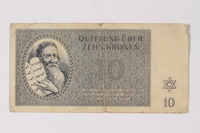
Theresienstadt ghetto-labor camp scrip, 10 kronen note, saved by a former German Jewish inmate
Object
Theresienstadt scrip, value 10 [zehn] kronen, acquired by Alfred Fabian, an inmate in Theresienstadt ghetto-labor camp in German occupied Czechoslovakia from March 1943-October 1944. Currency was confiscated from deportees and the SS ordered the Jewish Council to create a currency for exchange only in the camp. This was to create an illusion of normalcy and there was little to buy. On May 17, 1943, Alfred, wife Ruth, 5 year old daughter Ingrid, and Alfred’s mother Erna were deported to Theresienstadt. On October 12, 1944, the family was sent to Auschwitz-Birkenau killing center, where Ruth, Ingrid, and Erna were gassed on arrival. On November 19, 1944, Alfred was sent to Niederorschel slave labor camp, a Buchenwald subcamp in Germany. Niederorschel was evacuated on April 1, 1945. Alfred was sent to Buchenwald where he was liberated April 11 by the 761st Tank Battalion, US Army.
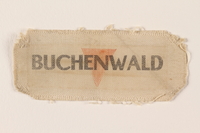
Cloth patch printed Buchenwald over a red inverted triangle worn by a German Jewish man
Object
Buchenwald prisoner badge worn by Alfred Fabian in Niederorschel and Buchenwald concentration camps from November 19, 1944, to April 11, 1945. The inverted red triangle on the badge signifies a political prisoner. On May 17, 1943, Alfred, wife Ruth, 5 year old daughter Ingrid, and Alfred’s mother Erna were deported to Theresienstadt ghetto-labor camp in Czechoslovakia. On October 12, 1944, the family was sent to Auschwitz-Birkenau killing center, where Ruth, Ingrid, and Erna were gassed on arrival. On November 19, 1944, Alfred was sent to Niederorschel slave labor camp, a Buchenwald subcamp in Germany. Niederorschel was evacuated on April 1, 1945. Alfred was sent to Buchenwald where he was liberated April 11 by the 761st Tank Battalion, US Army.
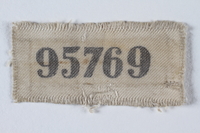
Prisoner ID badge number 95769 worn by a German Jewish man
Object
Prisoner identification patch worn by Alfred Fabian in Niederorschel and Buchenwald concentration camps from November 19, 1944, to April 11, 1945, printed with his prisoner number, 95769. On May 17, 1943, Alfred, wife Ruth, 5 year old daughter Ingrid, and Alfred’s mother Erna were deported to Theresienstadt ghetto-labor camp in Czechoslovakia. On October 12, 1944, the family was sent to Auschwitz-Birkenau killing center, where Ruth, Ingrid, and Erna were gassed on arrival. On November 19, 1944, Alfred was sent to Niederorschel slave labor camp, a Buchenwald subcamp in Germany. Niederorschel was evacuated on April 1, 1945. Alfred was sent to Buchenwald where he was liberated April 11 by the 761st Tank Battalion, US Army.
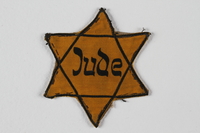
Star of David badge with Jude worn by a German Jewish man
Object
Star of David badge printed Jude, German for Jew, worn by Alfred Fabian in Berlin, Germany, from September 1941 to May 1943. On September 1, 1941, Jews were required to wear these badges to humiliate and separate them from the general public. On May 17, 1943, Alfred, wife Ruth, 5 year old daughter Ingrid, and Alfred’s mother Erna were deported to Theresienstadt ghetto-labor camp in Czechoslovakia. On October 12, 1944, the family was sent to Auschwitz-Birkenau killing center, where Ruth, Ingrid, and Erna were gassed on arrival. On November 19, 1944, Alfred was sent to Niederorschel slave labor camp, a Buchenwald subcamp in Germany. Niederorschel was evacuated on April 1, 1945. Alfred was sent to Buchenwald where he was liberated April 11 by the 761st Tank Battalion, US Army.



